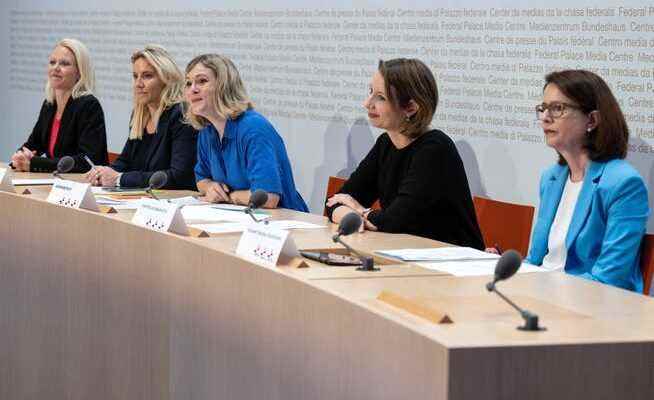A non-partisan women’s committee wants to convince the electorate to vote in favor of the AHV reform. However, the argument is very idiosyncratic.
Lilian Studer, Céline Amaudruz, Kathrin Bertschy, Christina Bachmann-Roth and Susanne Vinzenz-Stauffacher (from left to right) cautiously promoted raising the retirement age for women.
One has already seen more convincing voters than those politicians who presented their yes to the AHV reform on Monday as the “Women’s Alliance for Equality in Old-Age Provision”. The bill, which can be described as one of the most important of the current legislature, will go to the ballot box on September 25. The main point of contention is raising the retirement age for women from 64 to 65; the VAT increase of 0.4 percent, which is also being voted on, currently gives little to talk about.
It won’t be a Sunday stroll for the proponents to win the vote. Because the left-wing parties and trade unions are fighting the reform with vehemence: Gender equality at retirement age is a blatant injustice to women, as they are still often disadvantaged, they say.
Women should set the tone
On the other hand, the representatives of the Women’s Alliance from the FDP, GLP, Mitte, SVP and EVP said that you, as women, would be willing to work up to the age of 65. The AHV reform is fair, based on solidarity and urgently needed, as this is the only way the social work can be secured for future generations. With their commitment, the quintet wants to ensure that women primarily set the tone in AHV dossiers. The Alliance was founded so that men would not primarily explain to women what was good or bad for them, said Green Liberal National Councilor Kathrin Bertschy. The AHV proposal is recommended by the five politicians for acceptance, not least because it provides pension supplements solely for women, as Bertschy said.
However, the women’s alliance’s yes to the AHV proposal does not seem too courageous. At the same time, the politicians insisted that there was still a lot to do before equality was achieved. Bertschy, co-president of the women’s organization Alliance F, said that women of retirement age are significantly worse off financially than men and receive 37 percent less pensions across all three pillars of pension provision. “That’s almost 20,000 francs that they miss every year.” SVP National Councilor Céline Amaudruz criticized the fact that women still earn less than men for the same work and are disadvantaged when they retire because they have children and part-time work is widespread. For National Councilor Susanne Vincenz-Stauffacher, President of the FDP Women, the current tax system is misogynistic. Christina Bachmann-Roth, President of Mitte-Frauen, complained that the federal government was investing far too little money in reconciling family and work.
Equality is not a one-way street, one now expects substantial improvements, according to the demands of the campaigners. Their ideas range from a massive increase in crèche funds and the fight against wage discrimination to better protection for small incomes in the pension funds and the switch to individual taxation. It remains to be seen whether the women’s alliance, with its long list of shortcomings and the “there is still a lot to be done” attitude, can convince voters of the AHV reform. It is quite possible that those who are undecided will ask themselves why they should vote yes when there is allegedly such a lack of equality everywhere.
The AHV itself is hardly an issue
Not much was heard from the women’s alliance on the AHV itself. For example, there was no mention of the fact that women benefit greatly from the first pillar and that billions are now redistributed from men to women every year. And the fact that women are prevented from generating income for a year longer and making contributions to the pension fund due to the lower retirement age was only mentioned in passing.
EPP National Councilor Lilian Studer chose a slightly different approach than her four fellow campaigners. She clearly opposed the catchy slogan of the left that women were the victims of the AHV reform and pointed to the generous treatment of the transitional generation: “A woman born in 1964 and on a small income has an average life expectancy of 21 years. With the AHV 21, she receives a monthly plus of 160 francs during these 21 years. That corresponds to an additional amount of 40,320 francs – a multiple of what is lost with a year less pension. » Studer also drew attention to a point that is often forgotten: the AHV proposal is not only being financed by equality in the retirement age, but also by an increase in VAT and thus by the general public.
